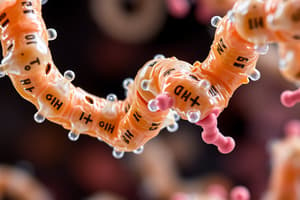Podcast
Questions and Answers
What is bioenergetics?
What is bioenergetics?
- A method of energy conservation
- The overall flow and transformation of energy in an organism (correct)
- The study of how energy flows through organisms (correct)
- The energy produced in cellular respiration
What are enzymes?
What are enzymes?
Proteins that act as biological catalysts
What do organic catalysts do?
What do organic catalysts do?
Speed up the rate of a reaction without altering the reaction itself
What are exergonic reactions?
What are exergonic reactions?
What are endergonic reactions?
What are endergonic reactions?
What is activation energy?
What is activation energy?
What does enzyme specificity mean?
What does enzyme specificity mean?
What are substrates?
What are substrates?
What is the active site?
What is the active site?
Substrate A + substrate B + enzyme -> ______ -> enzyme + product
Substrate A + substrate B + enzyme -> ______ -> enzyme + product
What is induced fit in enzymes?
What is induced fit in enzymes?
What are coenzymes?
What are coenzymes?
What are cofactors?
What are cofactors?
What are allosteric sites?
What are allosteric sites?
What are allosteric regulators?
What are allosteric regulators?
What is an allosteric inhibitor?
What is an allosteric inhibitor?
What is an allosteric activator?
What is an allosteric activator?
Allosteric enzymes are subject to ______ in which the formation of an end product inhibits an earlier reaction in the sequence
Allosteric enzymes are subject to ______ in which the formation of an end product inhibits an earlier reaction in the sequence
What is competitive inhibition?
What is competitive inhibition?
What is noncompetitive inhibition?
What is noncompetitive inhibition?
What does the first law of thermodynamics state?
What does the first law of thermodynamics state?
What does the second law of thermodynamics explain?
What does the second law of thermodynamics explain?
What is entropy?
What is entropy?
What is photosynthesis?
What is photosynthesis?
What is cellular respiration?
What is cellular respiration?
What is aerobic respiration?
What is aerobic respiration?
What is anaerobic respiration?
What is anaerobic respiration?
What is glycolysis?
What is glycolysis?
What is pyruvic acid?
What is pyruvic acid?
What is acetyl coenzyme A?
What is acetyl coenzyme A?
Flashcards are hidden until you start studying
Study Notes
Bioenergetics and Enzymes
- Bioenergetics refers to the flow and transformation of energy within organisms, focusing on how energy is utilized.
- Enzymes are proteins that function as biological catalysts, accelerating reactions by lowering activation energy without being consumed in the process.
- Organic catalysts, such as enzymes, enhance reaction rates without altering the reaction itself.
Types of Reactions
- Exergonic reactions release energy, resulting in products with less energy than the reactants.
- Endergonic reactions require energy input, producing products with higher energy than the starting reactants.
Enzyme Functionality
- Activation energy is the minimum energy required to initiate a chemical reaction.
- Enzymes exhibit specificity, catalyzing only a particular type of reaction.
- Substrates are the reactants upon which enzymes act, and they bind at the active site of the enzyme.
Complexes and Interactions
- The enzyme-substrate complex forms when substrates bind to enzymes, leading to product formation.
- Induced fit describes how enzymes slightly alter their shape to fit the substrates better during the reaction.
Cofactors and Coenzymes
- Coenzymes are organic molecules, often vitamins, that assist enzymes by transferring electrons or functional groups.
- Cofactors are inorganic elements, typically metal ions, essential for enzyme activity.
Enzyme Regulation
- Allosteric sites allow the binding of substrates or regulators, affecting enzyme activity.
- Allosteric regulators can either inhibit or activate enzyme functions.
- Feedback inhibition is a process where the end product of a metabolic pathway inhibits an enzyme involved earlier in the pathway.
Inhibition Types
- Competitive inhibition occurs when a substrate with a similar shape occupies the active site, preventing substrate binding.
- Noncompetitive inhibition happens when an inhibitor binds elsewhere on the enzyme, changing its shape and rendering it inactive.
Thermodynamics Principles
- The first law of thermodynamics states that energy cannot be created or destroyed; it remains constant in the universe.
- The second law of thermodynamics indicates that energy transfers lead to increased disorder (entropy).
Entropy
- Entropy quantifies the energy in a system that is no longer available for useful work, representing a tendency towards disorder.
Energy Transformation Processes
- Photosynthesis converts solar energy into chemical energy, formulated as: 6CO2 + 6H2O + sunlight → C6H12O6 + 6O2.
- Cellular respiration utilizes glucose and oxygen, represented by the equation: C6H12O6 + 6O2 → 6CO2 + 6H2O + ATP.
Cellular Respiration Types
- Aerobic respiration requires oxygen and includes steps: Glycolysis, Formation of Acetyl CoA, The Krebs Cycle, and Oxidative Phosphorylation.
- Anaerobic respiration occurs without oxygen.
Glycolysis and Subsequent Pathways
- Glycolysis breaks down glucose into two pyruvic acid molecules, occurring in the cytoplasm, yielding a net gain of 2 ATP and 2 NADH.
- Pyruvic acid, a product of glycolysis, is essential for both aerobic and anaerobic respiration pathways.
- Acetyl coenzyme A is formed from pyruvic acid in aerobic respiration, releasing CO2 and producing 2 NADH during the process.
Studying That Suits You
Use AI to generate personalized quizzes and flashcards to suit your learning preferences.





